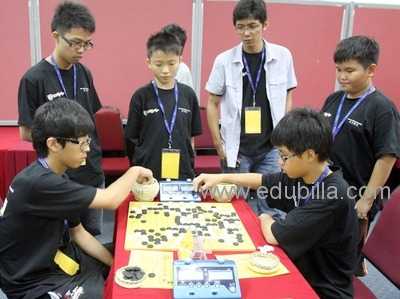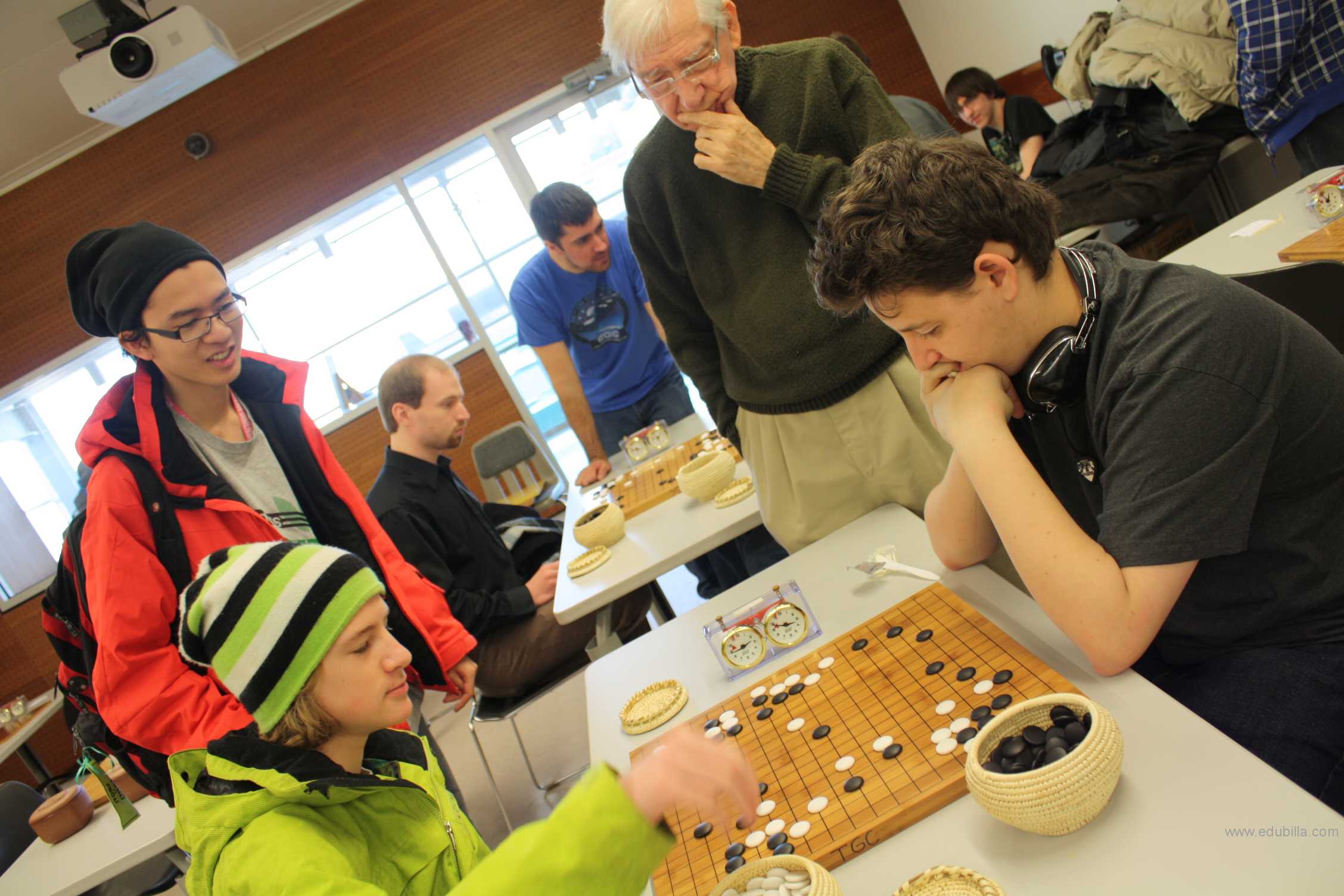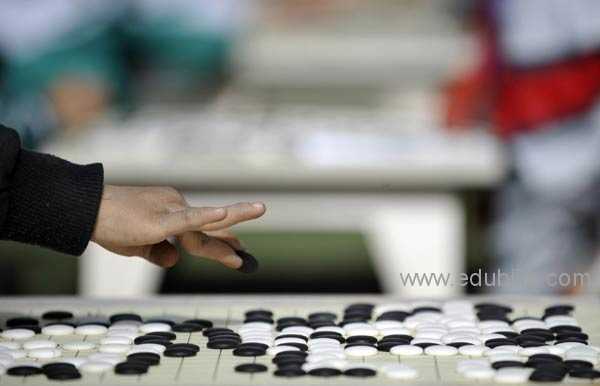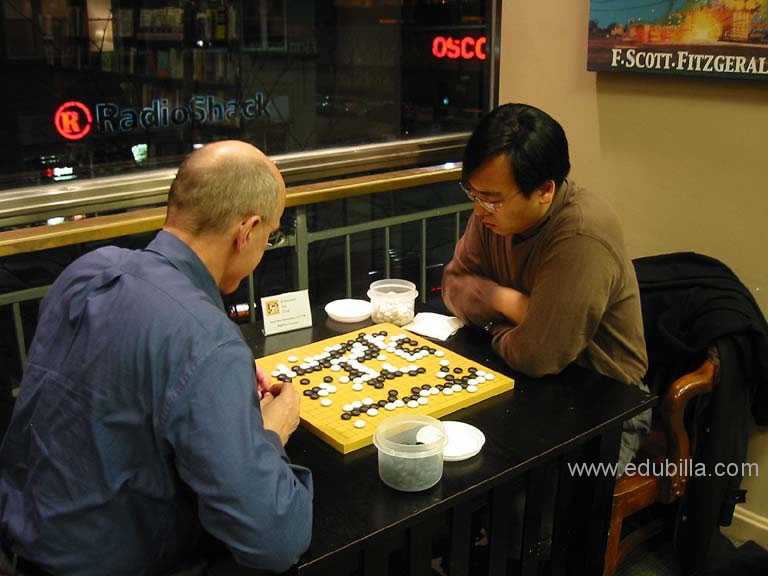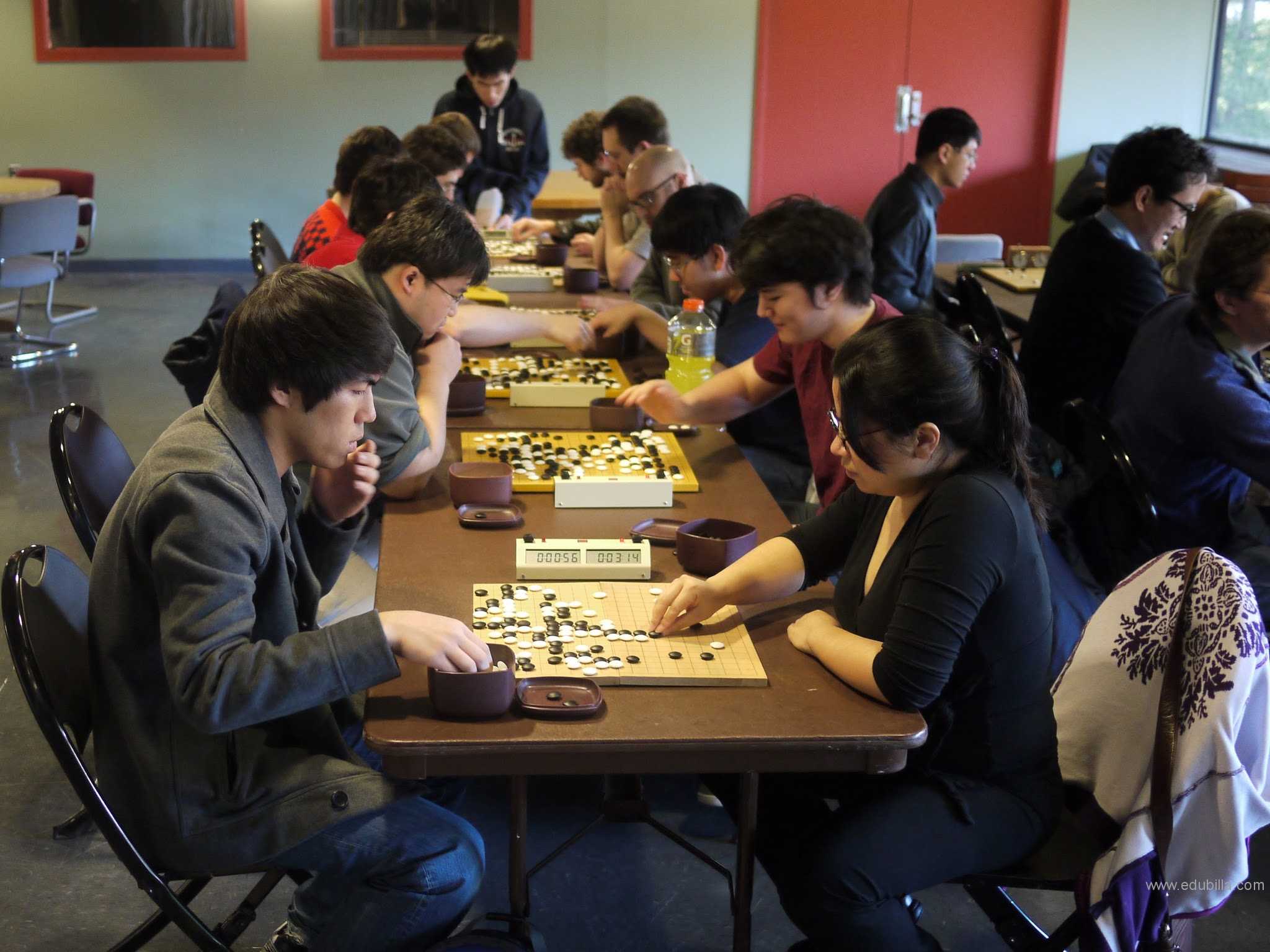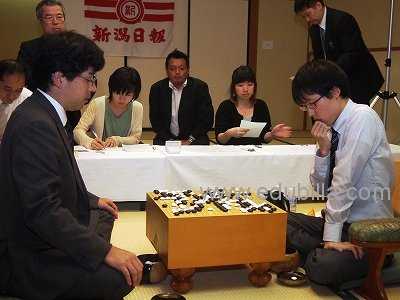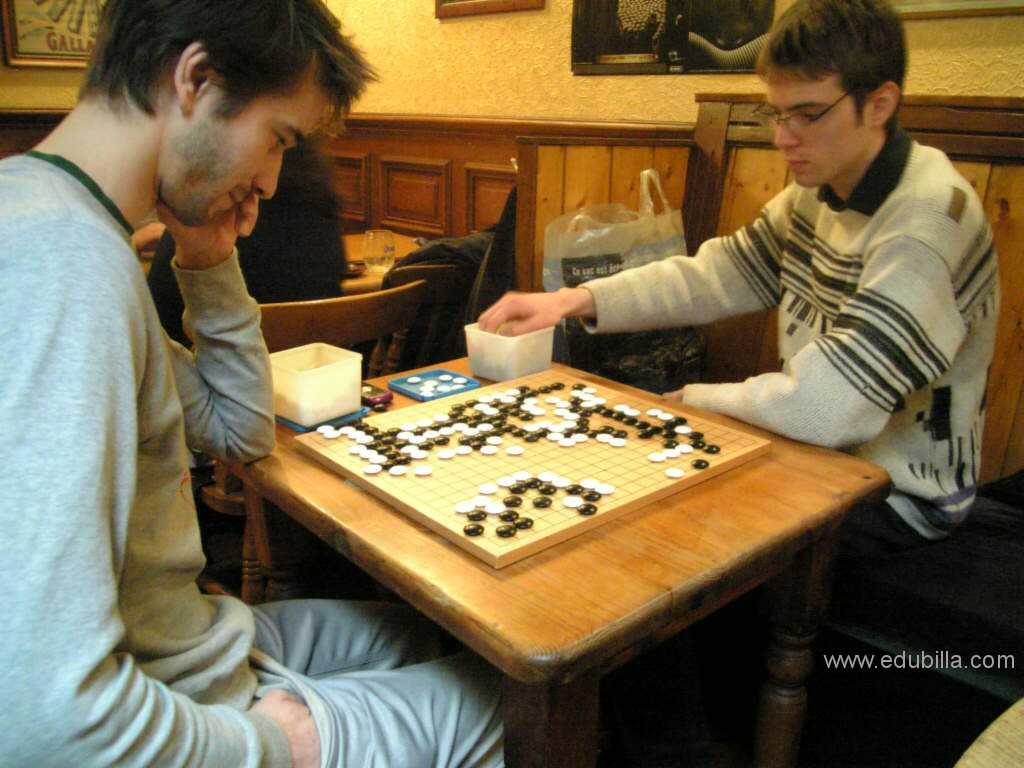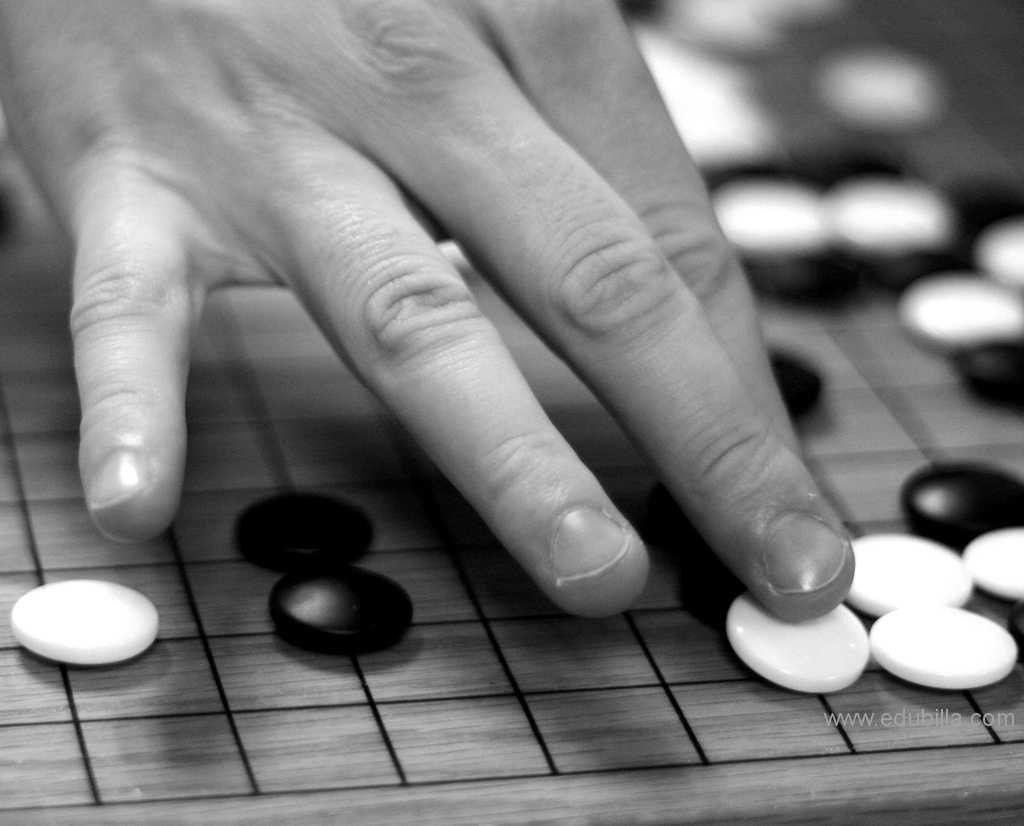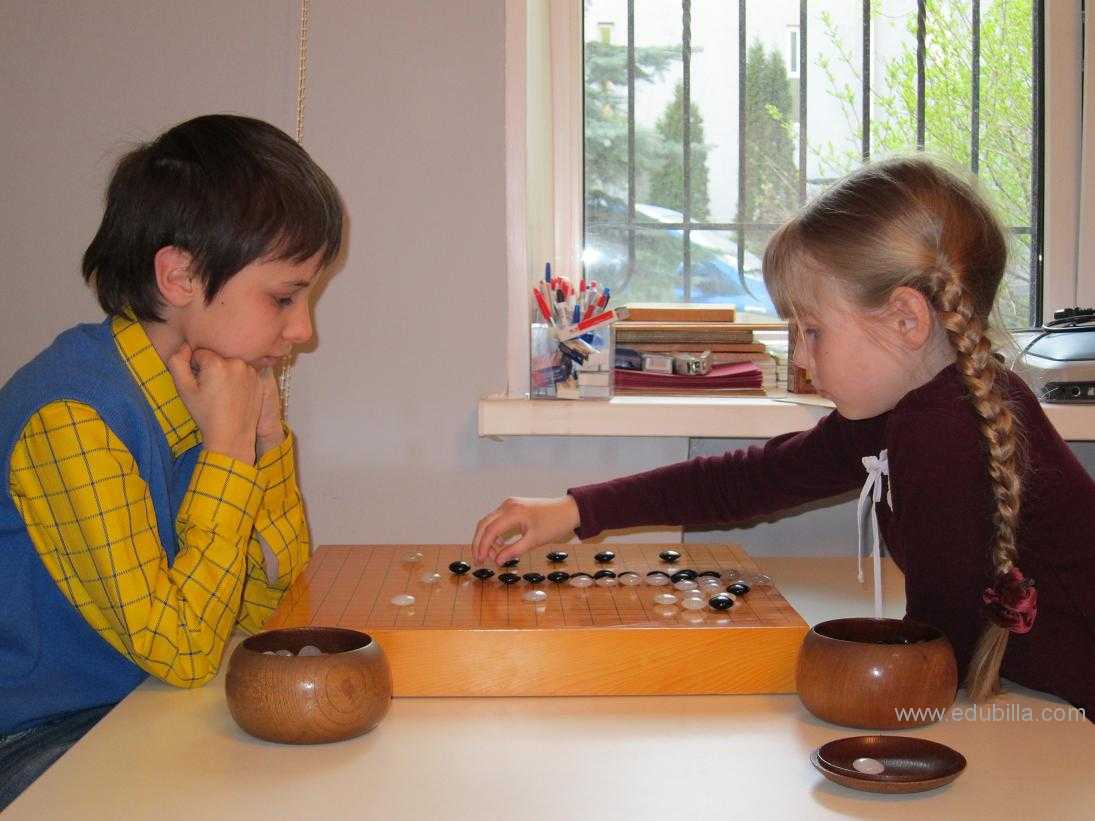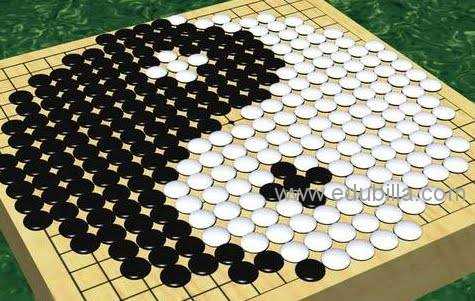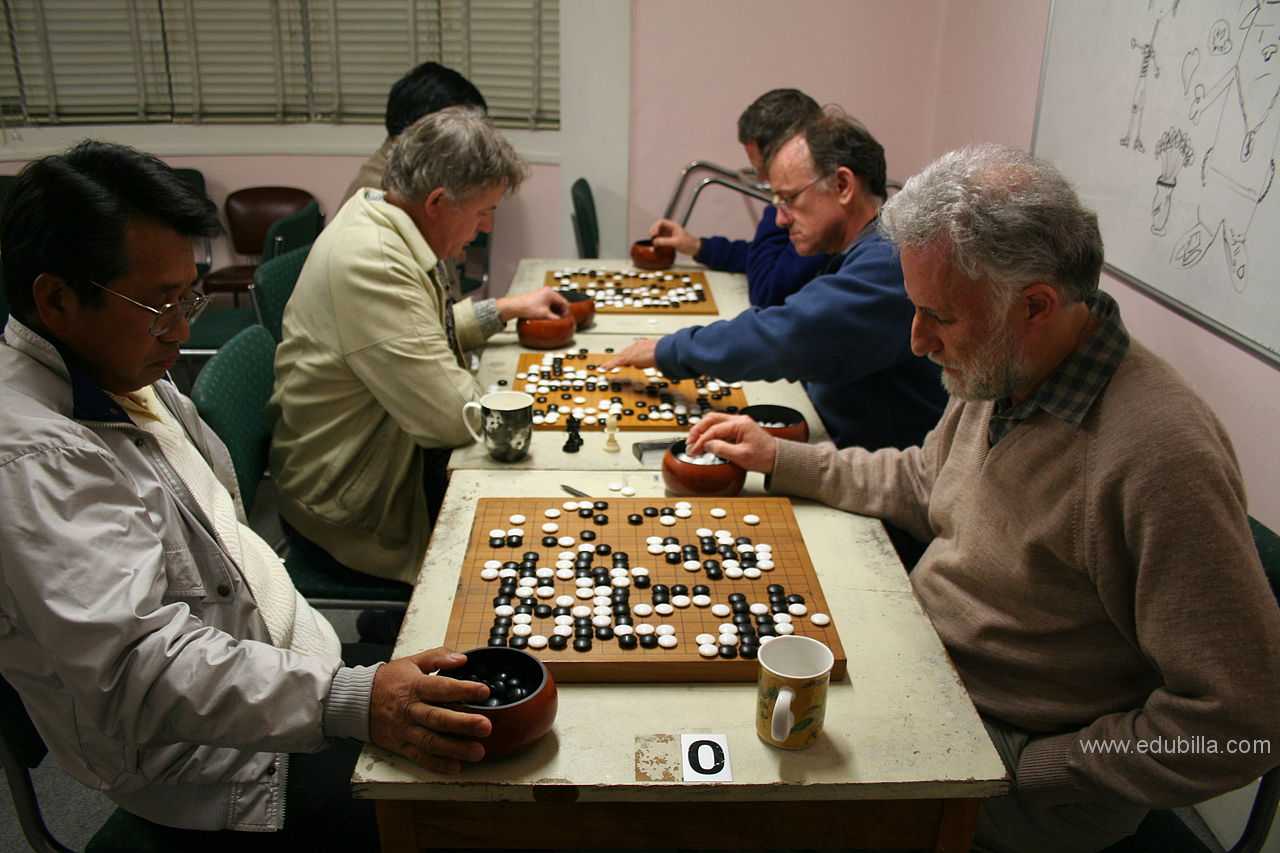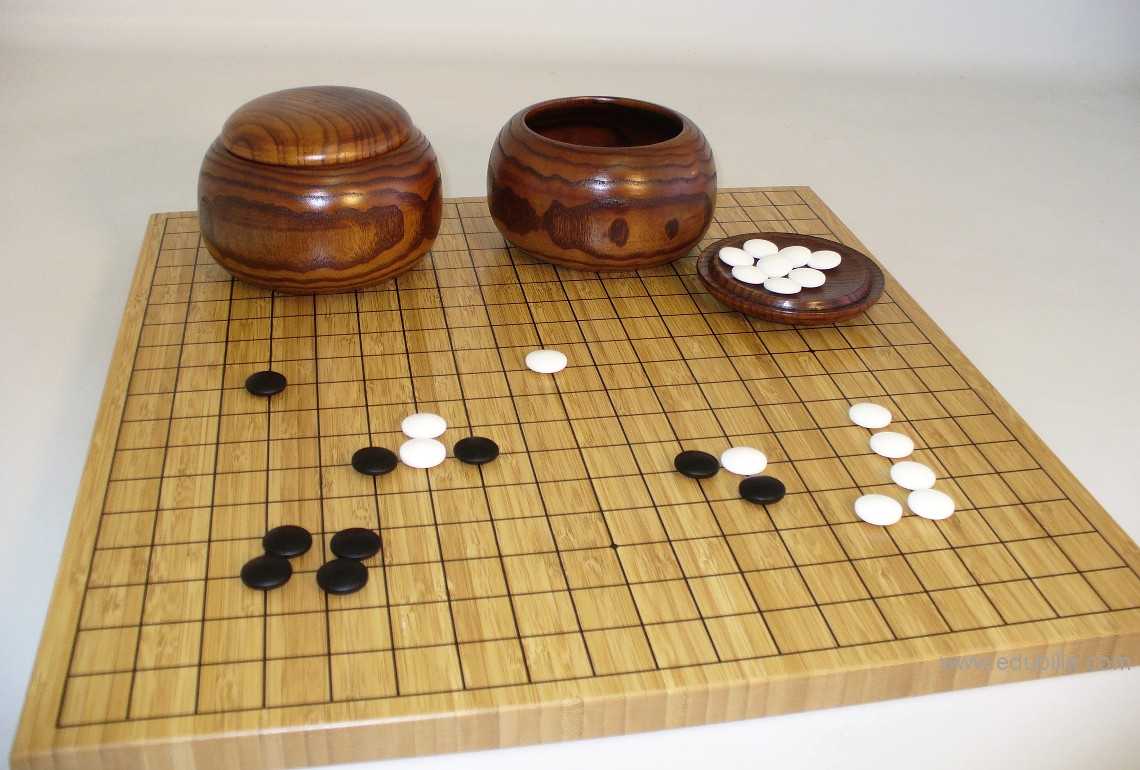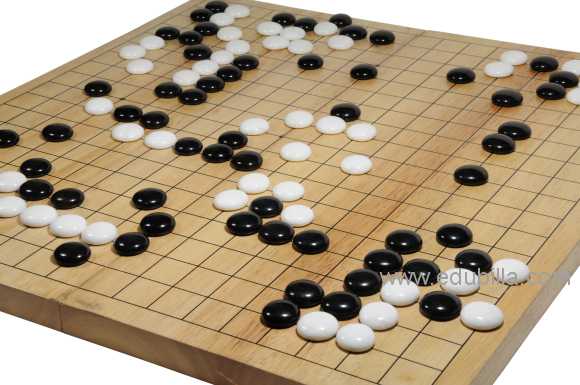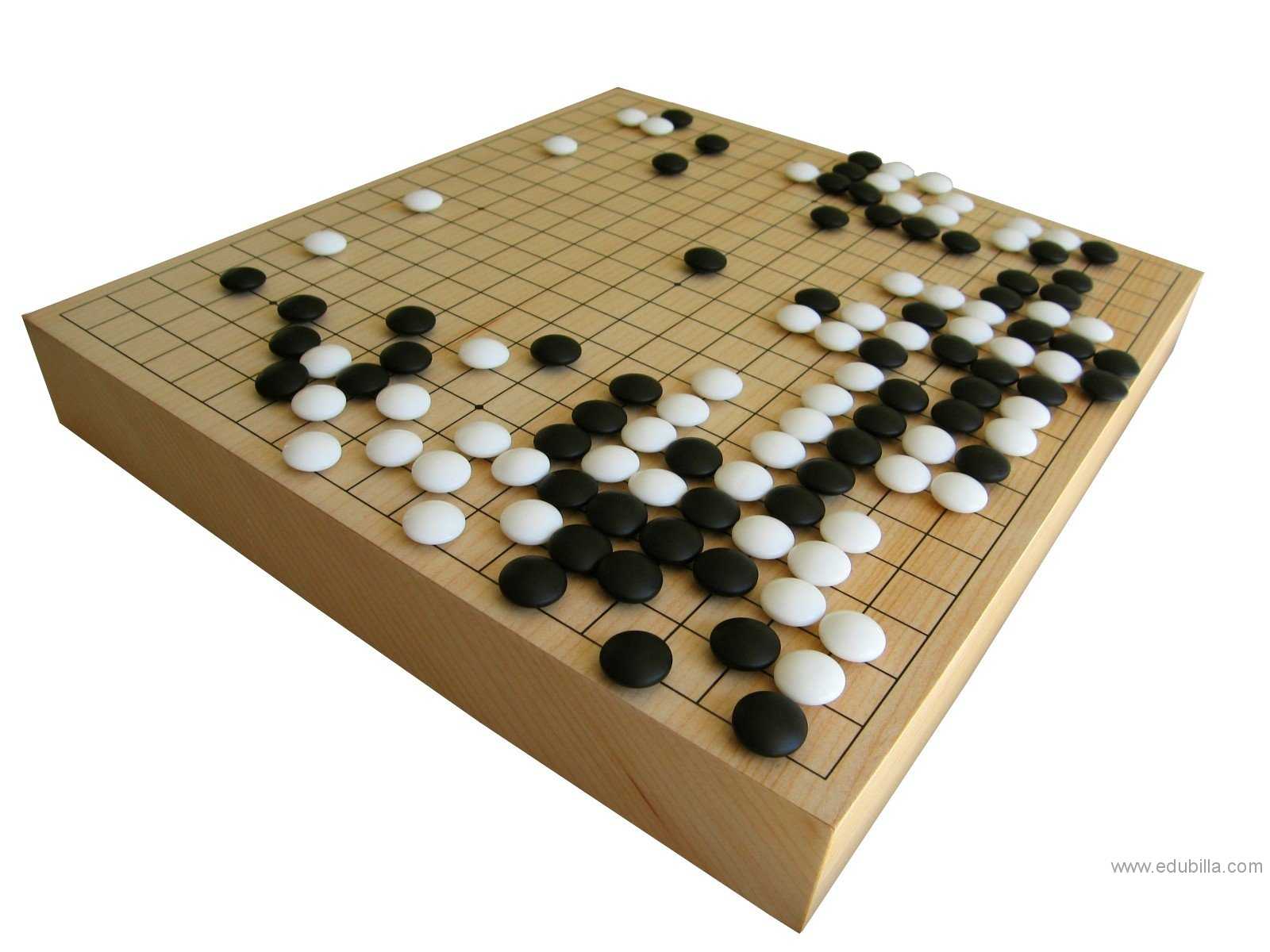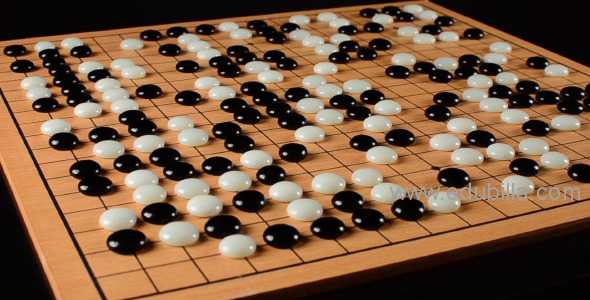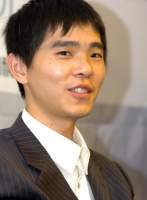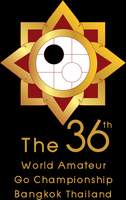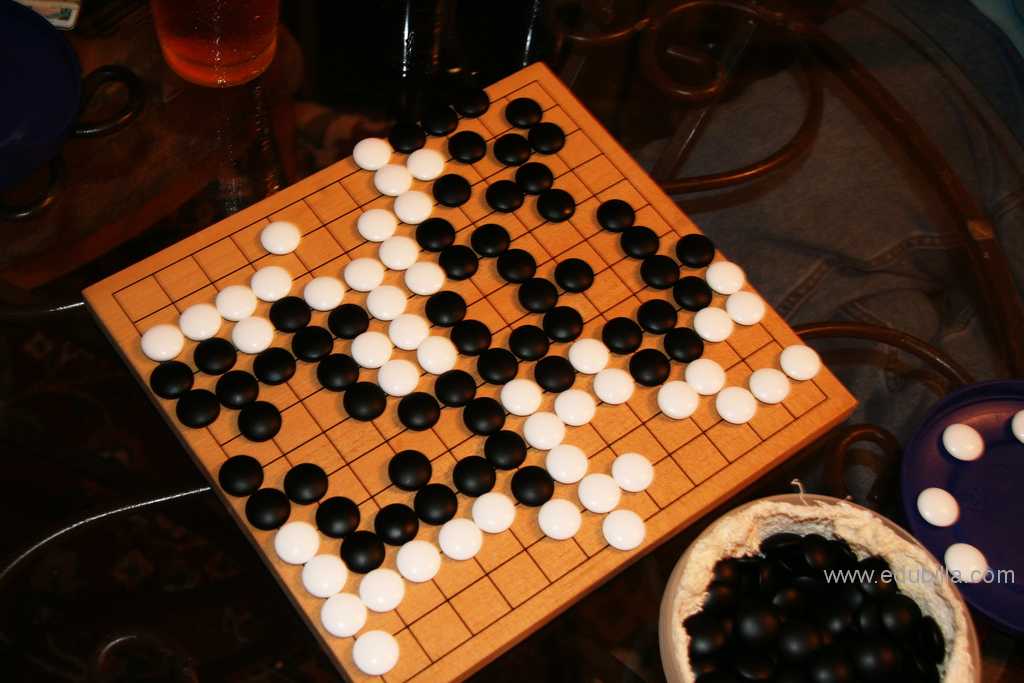
Overview Of Go (game)
Go is a board game involving two players, that originated in ancient China more than 2,500 years ago. It was considered one of the four essential arts of a cultured Chinese scholar in antiquity. The earliest written reference to the game is generally recognized as the historical annal Zuo Zhuan (c. 4th century BC).
There is significant strategy involved in the game, and the number of possible games is vast (10761 compared, for example, to the 10120 possible in chess),despite its relatively simple rules.The two players alternately place black and white playing pieces, called "stones", on the vacant intersections ("points") of a board with a 19x19 grid of lines. Beginners often play on smaller 9×9 and 13×13 boards, and archaeological evidence shows that game was played in earlier centuries on a board with a 17×17 grid. By the time the game had spread to Korea and Japan in about the 5th and 7th centuries CE respectively, however, boards with a 19×19 grid had become standard.
The Objective of the Game:
The objective of the game—as the translation of its name implies—is to have surrounded a larger total area of the board with one's stones than the opponent by the end of the game, although this result typically involves many more intricacies than simply using surrounding areas directly.
Once placed on the board, stones may not be moved, but stones may be removed from the board if captured—this is done by surrounding an opposing stone or group of stones by occupying all orthogonally-adjacent points.The two players place stones alternately until they reach a point at which neither player wishes to make another move; the game has no set ending conditions beyond this. When a game concludes, the territory is counted along with captured stones and komi (points added to the score of the player with the white stones as compensation for playing second) to determine the winner.Games may also be won by resignation.
Game Rules
A set of rules suitable for beginners is presented here. In some respects, these differ from the rules most commonly used. However, the basic rules are simply stated, and provide a convenient basis on which to discuss differences in rulesets. The rules are studied more fully in Explanation of the basic rules below.
Two statements of the same basic rules, differing only in wording, are given here. The first is a concise one due to James Davies. The second is a formulation of the basic rules used for expository purposes in this article.
Except for terminology, the basic rules are identical to the Logical Rules first proposed in their current form in September 1996 by John Tromp and Bill Taylor. They are also quite close to the Simplified Ing Rules of the European Go Federation, the only exception being the method of ending the game.
Concise statement:
- These rules appear in "The Rules and Elements of Go" by James Davies. They assume familiarity with the equipment used to play go, for which one may refer to Elements of the game below.
- The board is empty at the onset of the game (unless players agree to place a handicap).
- Black makes the first move, after which White and Black alternate.
- A move consists of placing one stone of one's own color on an empty intersection on the board.
- A player may pass their turn at any time, but must sacrifice one of their prisoners (captured pieces).
- A stone or solidly connected group of stones of one color is captured and removed from the board when all the intersections directly adjacent to it are occupied by the enemy. (Capture of the enemy takes precedence over self-capture.)
- No stone may be played so as to recreate a former board position.
- Two consecutive passes end the game. However, since black begins, white must end the game.
- A player's territory consists of all the points the player has either occupied or surrounded.
- The player with more territory wins.
Reference statement:
The basic rules are formulated here in a more detailed way to ease their presentation in the section #Explanation of the basic rules below. (Each rule and definition links to a detailed explanation in that section.)
An optional rule prohibiting suicide is included as Rule 7A.
Players and equipment:
Rule 1.Players: Go is a game between two players, called Black and White.
Rule 2.Board: Go is played on a plain grid of 19 horizontal and 19 vertical lines, called a board.
Definition. ("Intersection", "Adjacent") A point on the board where a horizontal line meets a vertical line is called an intersection. Two intersections are said to be adjacent if they are connected by a horizontal or vertical line with no other intersections between them.
Rule 3.Stones: Go is played with playing tokens known as stones. Each player has at their disposal an adequate supply (usually 180) of stones of the same color.
Positions:
Rule 4.Positions: At any time in the game, each intersection on the board is in one and only one of the following three states: 1) empty; 2) occupied by a black stone; or 3) occupied by a white stone. A position consists of an indication of the state of each intersection.
Definition.("Connected") Two placed stones of the same color (or two empty intersections) are said to be connected if it is possible to draw a path from one intersection to the other by passing through adjacent intersections of the same state (empty, occ. by white, or occ. by black).
Definition.("Liberty") In a given position, a liberty of a stone is an empty intersection adjacent to that stone or adjacent to a stone which is connected to that stone.
Play:
Rule 5.Initial position: At the beginning of the game, the board is empty.
Rule 6. Turns: Black moves first. The players alternate thereafter.
Rule 7.Moving: When it is their turn, a player may either pass (by announcing "pass" and performing no action) or play. A play consists of the following steps (performed in the prescribed order):
Step 1. (Playing a stone) Placing a stone of their color on an empty intersection (chosen subject to Rule 8 and, if it is in effect, to Optional Rule 7A). It can never be moved to another intersection after being played.
Step 2. (Capture) Removing from the board any stones of their opponent's color that have no liberties.
Step 3. (Self-capture) Removing from the board any stones of their own color that have no liberties.
Optional Rule 7A. Prohibition of suicide: A play is illegal if one or more stones of that player's color would be removed in Step 3 of that play.
Rule 8.Prohibition of repetition: A play is illegal if it would have the effect (after all steps of the play have been completed) of creating a position that has occurred previously in the game.
End:
Rule 9. End: The game ends when both players have passed consecutively. The final position is the position on the board at the time the players pass consecutively.
Definition. ("Dead") In the final position, stones are said to be dead if the players agree they would inevitably be removed if the game continued.
Definition. ("Territory") In the final position, an empty intersection is said to belong to a player's territory if, after all dead stones are removed, all stones adjacent to it or to an empty intersection connected to it are of that player's color.
Definition. ("Area") In the final position, an intersection is said to belong to a player's area if either: 1) it belongs to that player's territory; or 2) it is occupied by a stone of that player's color.
Definition. ("Score") A player's score is the number of intersections in their area in the final position.
Rule 10. Winner: If one player has a higher score than the other, then that player wins. Otherwise, the game is drawn.
Comparative features of the basic rules:
The essential features of these basic rules relative to other rulesets are summarized here. Each of the differences is discussed in greater detail in a later section of the article.
What variation exists among rulesets concerns primarily Rules 7A, 8, 9 and 10.
- The basic rules use area scoring, as in China and Taiwan, and as in the official rules of many Western countries. The main alternative is territory scoring. Though territory scoring is the system used in Japan and Korea, and is customarily used in the West, it is not possible to use territory scoring unless Rule 9 is replaced by a much more complex end-of-game rule. The goal of these basic rules is to present a simple system first. See the section "Scoring systems" below.
- The basic rules, require the players to "play the game out" entirely, capturing all dead stones in normal play. Virtually all rulesets used in practice provide some mechanism that allows players to begin scoring the game before the final position (the one used to score the game) has been reached. In some cases, this is merely a convenience intended to save time. In others, it may be an essential feature of the game. In any case, explaining these rules might obscure the nature of the game somewhat for a person unfamiliar with it. See the section "Counting phase" below.
- The basic rules allow suicide (or self-capture). This is unusual outside of Taiwan and New Zealand. Inclusion of Optional Rule 7A is in line with practice elsewhere. See the section "Suicide" below.
- The basic rules apply the rule of positional superko. This, or a similar rule, is common in official Western rulesets, but not in East Asia. See the section "Repetition" below.
- The basic rules do not contain any special exceptions for territory in a seki. This agrees with most practice outside Japan and Korea. See the section "Seki" below.
- The basic rules do not have a komi. This is now unusual in even-strength games, but was common practice until the mid-twentieth century. A komi is a number of points, usually five to eight, awarded to White in compensation for moving second. See the section "Komi" below.
- The basic rules make no provision for the use of handicap stones. See the section "Handicap" below.
- The basic rules do not specify a counting system. A counting system is a conventional method for calculating the difference in score between the players (hence determining the winner). It may incorporate various devices, such as filling in one's territory after the game, or shifting stones on the board into patterns, which allow quicker calculation of the difference in scores.
Equipments Need For Go (game)
Board:
The Go board, called the goban ?? in Japanese, is the playing surface on which to place the stones. The standard board is marked with a 19x19 grid. Smaller boards include a 13x13 grid and a 9x9 grid used for shorter games that are often used to teach beginners. Some 19x19 boards have a 13x13 grid on the reverse side. 17x17 was used in historical times. Chinese boards are generally square; Japanese and Korean boards are slightly longer than wide, so that they appear square when viewed from a normal playing position. In Asian go parlors, the tables are slightly lower than the typical game table so that the players can clearly see the positions of the stones.
Go boards fall into several types or styles.
- Economical boards comprise paper, plastic, or laminate, which can easily be folded away and stored. They are often used by beginners or for when one does not have a proper set available. A board can be hand-drawn on a stiff piece of cardboard for the super-economical.
- Boards that comprise fabric, paper, or plastic may be rolled into a tube and easily carried along with stones to make a portable set. Some materials hold strongly onto the warp though and need to be weighted at the corners to make the board usable when unrolled.
- Magnetic sets are also available, which comprise metal boards and stones that include magnets. They are useful for traveling. Large magnetic boards are also available for demonstration purposes, during lectures and other presentations.
- Wooden boards, one to two inches thick, are commonly used. They are known as "table boards" because they are placed on tables (compare "floor board" below.) The wood grain is pleasing to the eye, and the stones make a nice sound when placed firmly on the board. Portable boards can be made with hinges or slots. Some have grids on the reverse. Boards have been made from almost every type of wood, which includes particle board with or without veneer. Wood, such as spruce or katsura ?, that has a light color with a fine grain that does not compete with the grid lines is considered most suitable. The most valued boards are made from kaya, which is a mellow yellow. Also available are bamboo boards. The tensile strength of bamboo is comparable to that of steel making it very durable but also heavier than other wooden boards of the same size.
- A wooden floor board with legs is the most traditional, elegant, and expensive of all boards. Historically, to play on these boards, the Japanese would sit on tatami mats. These boards are still used for important tournament games in Asia. Chinese versions of floor boards are not always made from blocks of wood, and more closely resemble a small table with an inlaid go board. The legs raise the board to the correct height. The board can range from 14–21 cm high. The thickest boards are the most elegant. The undersides often have a square recesses (heso) to prevent warping and to amplify the sounds of the stones hitting the surface. The best boards are made from Miyazaki kaya, which is rare. These are classified according to the quality of the wood grain. Itame refers to a bent or irregular grain; masame refers to consistent grain that runs straight across the top of the board. Masame boards are further classified as tenmasa (the top grain is straight, but grain along the cut end is curved, as in the illustration), and most-prized tenchimasa (grain is straight along the cut end as well as on top.) Prices of kaya boards range from $1,000 to $20,000 plus. Boards made of other woods, such as Alaskan spruce, Agathis, or katsura are cheaper, around $500 to $2,000.
Stones:
Go stones, or go-ishi ??,??, are round objects placed on the board. They are colored either black or white, for each player, and normally number 181 for black and 180 for white (or sometimes 180 for each).
There are two styles or shapes of stones depending on where a player obtains them from:
- The Japanese and Korean style, which is lens shaped (i.e. biconvex). This is the most popular style.
- The Chinese style, called yunzi ??,??, or 'cloud', because they are normally flat underneath and convex on top. This style is less common outside of China. Flat bottom stones can be useful for post-game analysis; by placing stones upside down, players can easily keep track of which stones were part of the original game. However, they are harder to pick up when clearing them from the board.
Stone dimensions:
Stone thickness can also vary, from as low as 4 millimeters or as high as 12.8 millimeters, with most between 7.0 mm and 10.1 mm for biconvex and 5–7 mm for single convex. Thick slate and shell stones can last for generations, slowly becoming thinner from handling, and gradually acquiring an ivory-like patina. The diameter of the stones is standardized to around 22 mm ±1 mm, which can fit almost all Go boards. Black stones are slightly larger in diameter to compensate for optical illusion of the white stones appearing larger when placed with black stones of the same diameter. This mostly applies to Korean and Japanese stones – Chinese stones tend to be sometimes larger in diameter, but they do come in different standard sizes. A Chinese "large" size is about 23 mm in diameter while "medium" is about 22 mm. Chinese board dimensions is also accordingly larger to accommodate them. See also some comparative measurements of various go stone sets.
Plastic stones:
Generally, these are the cheapest stones available. They range from flat, counter shaped to the typical lens shape. Price ranges from around $5–$30.
One specific type of plastic stone is called the Ing stone, manufactured by the Ing Chang-ki Wei-chi Education Foundation. These are the official stones of the Ing Foundation and have some extra weight to them due to metal inserted in the middle of the stone. They are 10 mm thick and sometimes come in an Ing Bowl, which is specially designed to count them (Ing rules require each player to start with exactly 180 stones).
Bowls:
A bowl's lid is usually rather loose and not tightly fit. A player traditionally places the lid upside down next to the open bowl and keeps stones there that they have captured from the opponent. The lid is placed so it's easily visible by the opponent, so each player knows how many prisoners the opponent has that are physically removed from the playing board.
The Go bowl can be made of several different materials.
Plastic: Very cheap, they can be cylinder shaped or square shaped. The price is around $5. Quart size plastic food storage containers can also be used.
Straw: Mostly used by the Chinese. They are made of woven straw. The price is around $10–25.
Wood: The most common material used to make bowls. The type of wood used affects the price considerably. Mulberry is one of the most striking and expensive. Intermediate woods are quince (karin in Japanese), kaya, cherry, keyaki, and rosewood. Cheaper ones are made out of beech or chestnut. Bamboo also makes for a nice, low-cost bowl. The bowl can be polished. The best bowls are carved from a single piece of wood and have their grains highlighted. The price range varies from $50 to thousands of dollars.
History Of Go (game)
The game of Go originated in China in ancient times. It was considered one of the four essential arts of a cultured Chinese scholar in antiquity and is described as a worthy pastime for a gentleman in the Analects of Confucius. It reached Korea by the 5th century, in the 7th century it had reached Japan. The game was described by Thomas Hyde in 1694, but it did not become popular in the West until the late 19th century.
Chinese Emperor Yao:
According to legend, the game was created as a teaching tool after the ancient Chinese Emperor Yao ? (2337 - 2258 BC) designed it for his son, Danzhu ??, to learn discipline, concentration, and balance. Another suggested genesis for the game is that Chinese warlords and generals used pieces of stone to map attacking positions. Other plausible theories relate Go equipment to divination or flood control.
Go Board :
Chinese archaeologists have discovered a broken piece of a pottery go board from the Western Han Dynasty (206 BC - 24 AD) in Shaanxi Province. This is the earliest discovery of an existing board unearthed in China. A picture can be found here (third picture down).
The board was found in the ruins of a watchtower at the tombs of Emperor Jingdi and Empress Wang Zhi of the Western Han Dynasty. The broken fragment of the board measures 5.7 cm to 28.5 cm long, 17 cm to 19.7 cm wide and 3.6 cm thick.
Li Gang, a research fellow with the Shaanxi Provincial Archaeological Research Institute, said that this board might have been made from a floor tile, and that it did not belong to the royal family since the carvings are too rough. Li said the board could have been made by the tomb guards who played go to pass the time. "That proves that go was being played not only by nobles, but also by ordinary people like tomb guards, more than 2,000 years ago," Li noted.
In 1954 a complete Go board made out of stone was found in a tomb dating to the Eastern Han Dynasty (25-220) in Wangdu County, Hebei Province. This board has a 17 × 17 grid, which confirms the statement by the 3rd century author Handan Chun in the Classic of Arts that Go was at this time played on a 17 × 17 grid:
- The go board has 17 lines along its length and breadth, making 289 points in all. The black and white stones each number 150.
The earliest board with a 19 × 19 grid to have been found is a ceramic board dating to the Sui Dynasty (581-618) that was excavated from Anyang in Henan Province, so sometime between the 3rd and 6th centuries a change in grid size must have taken place. However, the 17 × 17 board has survived in the version of Go played in Tibet.
Growth in East Asia:
Go is believed to have been introduced to Japan by Kibi Makibi who had studied in Tang China at the beginning of the 8th century. But the Taiho Code, enacted in 701, has a description of Go and therefore the game may have been introduced a little earlier. After it was introduced from China, Go came to be actively played during the Nara period (710-794), and during the following Heian period (794-1185) Go was a favourite aristocratic pastime, as is described in typical literary works of this period such as The Pillow Book and The Tale of Genji.
Go Teachers:
During the Muromachi period (1336–1573), potentates employed semi-professional Go players, called Go-uchi (???) or Uwate (??) who competed against other clans. At the end of the 16th century, Nikkai (Honinbo Sansa) served Oda Nobunaga, Toyotomi Hideyoshi and Tokugawa Ieyasu as a Go teacher, and in 1578 was recognized as the first Meijin of Go by Oda Nobunaga; he also became the first Honinbo.
Edo period:
In 1612, at the beginning of the Edo period (1603–1868), the Tokugawa Shogunate established Four hereditary "houses" to teach the game of Go: Honinbo (??? Honinbo?), Hayashi (? Hayashi?), Inoue (?? Inoue?) and Yasui (?? Yasui?). These four houses (Iemoto) competed with each other throughout the 300 years of the Edo period.
First Recorded Games:
The first recorded games of Go in Europe was played in 1872 between Kido Takayoshi and Okubo Toshimichi. Both were vice ambassadors of the Iwakura Mission, which traveled to the United States and Europe between 1871 and 1873. Kido was an enthusiastic go player, as can be seen from his diary (translated by Sidney DeVere Brown and Akiko Hirota as The Diary of Kido Takayoshi, Vol. I-III, Tokyo, The University of Tokyo Press, 1983–1986). During his journey, after arriving at Birmingham on 1 November 1872 and staying at the Queen's Hotel in Room No. 10, Kido notes two days later in his diary (Vol. II, p. 243):
Go in America:
The earliest go players in North America were probably Chinese workers toiling on the transcontinental railroad in the mid-1800s, but if so the game did not attract notice outside the Chinese-American community.
Go first came to the attention of Westerners in the early 1900s when a group of German mathematicians and game players stumbled upon it, including Otto Korschelt and Edward Lasker, a cousin of the legendary chess legend Emanuel Lasker and himself a well-known top player. With Lee Hartmann (editor of Harper's magazine) and a few others, Lasker formed the American Go Association in New York in 1937.
Origin Of Go (game)
Origin in China:
The earliest written reference to the game is generally recognized as the historical annal Zuo Zhuan (c. 4th century BC), referring to a historical event of 548 BC. It is also mentioned in Book XVII of the Analects of Confucius and in two books written by Mencius (c. 3rd century BC). In all of these works, the game is referred to as yì . Today, in China, it is known as weiqi, literally the "encirclement board game".
First played :
Go was originally played on a 17×17 line grid, but a 19×19 grid became standard by the time of the Tang Dynasty (618–907). Legends trace the origin of the game to the mythical Chinese emperor Yao (2337–2258 BC), who was said to have had his counselor Shun design it for his unruly son, Danzhu, to favorably influence him. Other theories suggest that the game was derived from Chinese tribal warlords and generals, who used pieces of stone to map out attacking positions.In China, Go was considered one of the four cultivated arts of the Chinese scholar gentleman, along with calligraphy, painting and playing the musical instrument guqin.
Spread to Korea:
Weiqi was introduced to Korea sometime between the 5th and 7th centuries CE, and was popular among the higher classes. In Korea, the game is called baduk (hangul: ??), and a variant of the game called Sunjang baduk was developed by the 16th century. Sunjang baduk became the main variant played in Korea until the end of the 19th century.
Spread to Japan:
The game reached Japan in the 7th century CE—where it is called go or igo —the game became popular at the Japanese imperial court in the 8th century, and among the general public by the 13th century. In 1603, Tokugawa Ieyasu re-established Japan's unified national government. In the same year, he assigned the then-best player in Japan, a Buddhist monk named Nikkai (né Kano Yosaburo, 1559), to the post of Godokoro (Minister of Go). Nikkai took the name Honinbo Sansa and founded the Honinbo Go school. Several competing schools were founded soon after.These officially recognized and subsidized Go schools greatly developed the level of play and introduced the dan/kyu style system of ranking players. Players from the four schools (Honinbo, Yasui, Inoue and Hayashi) competed in the annual castle games, played in the presence of the shogun.
Go in the West:
Despite its widespread popularity in East Asia, Go has been slow to spread to the rest of the world. Although there are some mentions of the game in western literature from the 16th century forward, Go did not start to become popular in the West until the end of the 19th century, when German scientist Oskar Korschelt wrote a treatise on the game. By the early 20th century, Go had spread throughout the German and Austro-Hungarian empires. In 1905, Edward Lasker learned the game while in Berlin. When he moved to New York, Lasker founded the New York Go Club together with (amongst others) Arthur Smith, who had learned of the game while touring the East and had published the book The Game of Go in 1908. Lasker's book Go and Go-moku (1934) helped spread the game throughout the U.S., and in 1935, the American Go Association was formed. Two years later, in 1937, the German Go Association was founded.
World War II:
World War II put a stop to most Go activity, but after the war, Go continued to spread. For most of the 20th century, the Japan Go Association (Nihon Ki-in) played a leading role in spreading Go outside East Asia by publishing the English-language magazine Go Review in the 1960s; establishing Go centers in the U.S., Europe and South America; and often sending professional teachers on tour to Western nations. Internationally, the game is now commonly known by its shortened Japanese name, and terms for common Go concepts are derived from their Japanese pronunciation.
Go in space:
In 1996, NASA astronaut Daniel Barry and Japanese astronaut Koichi Wakata became the first people to play Go in space. They used a special Go set, which was named Go Space, designed by Wai-Cheung Willson Chow. Both astronauts were awarded honorary dan ranks by the Nihon Ki-in.
Governing Bodies
International Go Federation:
The International Go Federation (IGF) is an international organization that connects the various national Go federations around the world.

Role:
The role of the IGF is to promote the sport of Go throughout the world, promote amicable relations among members and improve world go organization. It does so by carrying out the following activities:
- Organizing the World Amateur Go Championship and other international Go tournaments;
- Publishing and distributing to members up-to-date information on world Go activities, through bulletins or on the IGF website;
- Other activities pertaining to the international development of Go.
History:
The Japan Go Association organized the first World Go Amateur Championship in Japan, in 1979. Many of the top Go players from around the world and representatives from the major National Go Associations attended the event. Its success led to the founding of the International Go Federation on March 18, 1982, with Shizuo Asada presiding over the original 29 founding members.
- On April 7, 2006, the IGF became a member of the General Association of International Sports Federations (GAISF).
- The IGF is a founding member of the IMSA (International Mind Sports Association).
- The IGF organizes the yearly World Amateur Go Championship, which attracts over 65 countries.
IGF Presidents:
- Shizuo Asada, Professional Go Player and founding President of the IGF, 1982–1997
- Fumio Watanabe, 1997–2001
- Matsuo Toshimitsu, 2001–2004
- Masao Kato, Professional 9-dan Go player, 2004–2005 (unfortunately was taken ill and died at the End of 2004)
- Norio Kudo, Professional 9-dan Go player, 2005–2007
- Hiromu Okabe, Chairman of the Board of Directors for the Nihon Ki-in, President of the Denso Corporation, 2007–2009
- Otake Hideo, Chairman of the Board of Directors for the Nihon Ki-in, 2009–2010
- Chang Zhenming, Vice-chairman and President of CITIC Group, 2010–2012
- Koichiro Matsuura, President of World Pair Go Association and former Director General of UNESCO, 2012-2014
- Seokhyun Hong, Chairman of the Korea Baduk Association, President of the Joongang Media Network, 2014-present
To Visit IGF Click Here.
Awards Related To Go (game)
COPSS Presidents' Award:
The COPSS Presidents' Award is given annually by the Committee of Presidents of Statistical Societies to a person under the age of 40, in recognition of outstanding contributions to the profession of statistics. It is arguably the most prestigious award in statistics, the Nobel Prize of Statistics. It is awarded by the five sponsoring statistical societies:
- The American Statistical Association (ASA)
- The Statistical Society of Canada (SSC)
- The Institute of Mathematical Statistics (IMS)
- The Eastern North American Region of the International Biometric Society (ENAR)
- The Western North American Region of the International Biometric Society (WNAR)
Sample Documents Of Go (game)
-Andre Agassi


